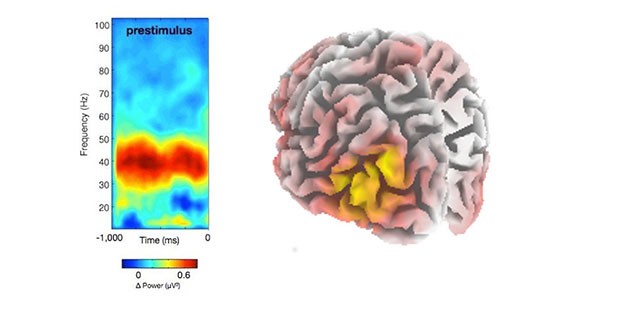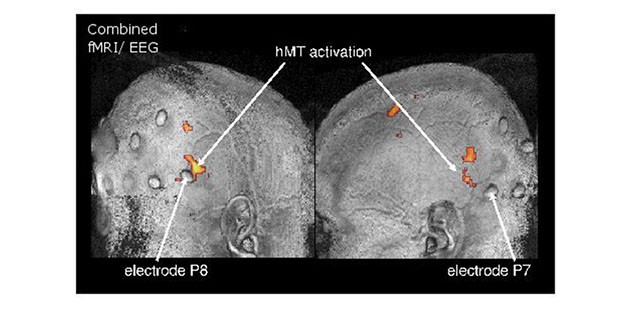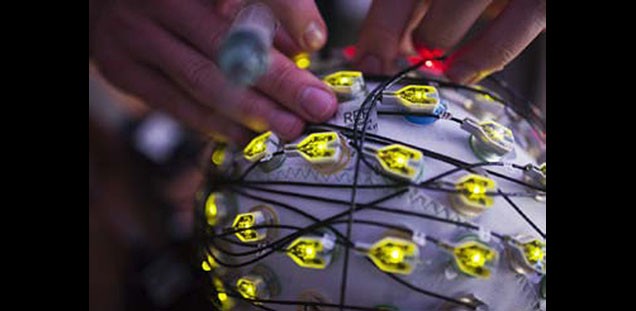
Research group

Research group

Research group
Overview
Our group investigates brain systems that are involved in the transformation of experience into enduring memories. Our research focuses on neural information processing in the context of implicit and explicit memory, cross-modal integration and the neural basis of pain. We are using functional magnetic resonance imaging (fMRI) and time-frequency based EEG analysis techniques to examine the systems that contribute to the different aspects of learning and memory. Combined fMRI- EEG experiments are used to describe locations and network dynamics involved in learning and memory. We further incorporate EEG- based Neurofeedback to modulate ongoing activity and examine the consequences for stimulus processing and memory formation.
- Staff
- Research topics
- Key publications
- Funding
- Collaborations
-
Staff
Jan Ostrowski is a doctoral student who joined our group in July 2021. In his research project, Jan focuses in the role of oscillatory brain states in the formation of associative crossmodal memory content. He will use EEG as well as combined EEG/fMRI measurements to investigate the involvement of particular oscillatory frequency bands and the neural correlates that are tied to crossmodal association learning. In this, brain states preceding stimulus presentation are of special interest.
Leonie Lambertz joined our group as a doctoral student in August 2024. Her PhD research explores the neural basis of expectation effects in pain and affective processing. She is particularly interested in how perceived control influences these mechanisms, using EEG Neurofeedback and fMRI.
Sebastian Heeren joined our group as a doctoral student in October 2024. In his PhD project, he investigates how affective contexts influence positive and negative expectations on pain. Utilizing fMRI, he explores the neural correlates of treatment expectations on pain and how they relate to emotion perception. This is part of combined efforts aiming to optimize the use of treatment expectations in clinical practice.
Alumni
Marike Maack
Christoph Wittkamp
Maren Wolf
Carina Jaap
Dr. Neda Salari
Dr. Signe-Luisa Winterling
Dr. Philipp Taesler
Julia Jablonowski
-
Research topics
- The neuronal basis of learning and memory
- Involvement of MTL structures in implicit learning
- The development of explicit access to implicitly learned information
- The effect of pre-stimulus activity on memory formation
- Neurofeedback
-
Key publications
Ostrowski, J., & Rose, M. (2024). Increases in pre-stimulus theta and alpha oscillations precede successful encoding of crossmodal associations. Scientific Reports, 14(1), 7895.
Wittkamp, C. A., Wolf, M. I., & Rose, M. (2024). The neural dynamics of positive and negative expectations of pain. Elife, 13, RP97793.
Wolf, M. I., Wittkamp, C. A., & Rose, M. (2024). Differential neural activity predicts the long-term stability of the effects of positive and negative expectations on pain. Scientific Reports, 14(1), 27874.
Jaap, C., & Rose, M. (2024). Relevance of pre-stimulus oscillatory activity for the perceived valence of emotional facial expressions. Scientific Reports, 14(1), 19263.
Strube A, Horing B, Rose M & Büchel C. Agency affects pain inference through prior shift as opposed to likelihood precision modulation in a Bayesian pain model. Neuron 2023; 111(7): 1136-1151.e7. doi: 10.1016/j.neuron.2023.01.002.
Taesler P & Rose M. Multivariate prediction of pain perception based on pre-stimulus activity. Scientific Reports 2022; 12(1): 1–9. doi.org/10.1038/s41598-022-07208-1 (20.2).
Jaap C, Maak M, Steinicke F & Rose M. Enriched Environments enhance the Development of Explicit Memory in an incidental learning task. Scientific Reports 2022; (20.2). doi: 10.1038/s41598-022-23226-5.
Jablonowski J & Rose M. The functional dissociation of posterior parietal regions during multimodal memory formation. Human Brain Mapping 2022; 43(11): 3469-3485. doi: 10.1002/hbm.25861.
Strube A, Rose M & Büchel C. The temporal and spectral characteristics of expectations and prediction errors in pain and thermoception . ELIFE 2021; 10: e62809. doi: 10.7554/eLife.62809.
Strube A, Rose M & Büchel C. Alpha-to-beta- and gamma-band activity reflect predictive coding in affective visual processing. Scientific Reports 2021; 2045-2322. doi: 10.1038/s41598-021-02939 z.
Taesler P & Rose M. The modulation of neural insular activity by a brain computer interface differentially affects pain discrimination. Scientific Reports 2021; 7;11(1):9795. doi: 10.1038/s41598-021-89206-3
Taesler P and Rose M. Pre-stimulus theta oscillations and connectivity modulate pain perception. Journal of Neuroscience 2016; 36(18); 5026-5033.
Schneider S and Rose M. Intention to encode boosts memory-related pre-stimulus EEG beta power. NeuroImage 2016; 125:978-987. doi: 10.1016/j.neuroimage.2015.11.024.
Bingel U, Rose M, Glascher J, Buchel C. fMRI reveals how pain modulates visual object processing in the ventral visual stream. Neuron 2007; 55: 157–167. doi.org/10.1016/j.neuron.2007.05.032.22
-
Funding
CRC 289 Treatment Expectation, Project A03: Prefrontal mechanisms of positive and negative expectation effects on pain: a combined EEG and fMRI study
SFB TRR 169: “Crossmodal Learning: Adaptivity, Prediction and Interaction”. Starting in 2016 the project within the Transregional Collaborative Research Center TRR169 funded by the DFG examines neurocognitive mechanisms for implicit learning of crossmodal predictions. The TRR is established as a Collaboration between Hamburg University and Beijing University. Project coordinator in Hamburg: Michael Rose
DFG Project RO 2653/6-1: „Funktion und Relevanz oszillatorischer prästimulus Aktivität für die Gedächtnisbildung“. Coordinator: Michael Rose
-
Collaborations
Prof. Dr. Hilde Haider
University of Cologne, GermanyProf. Dr. Rolf Verleger
University of Lübeck, GermanyProf. Dr. Qiufang Fu
Chinese Academy of Sciences, Beijing, ChinaProf. Dr. Xiaorong Gao
Biomedical Engineering, Tsinghua University, Beijing, ChinaDr. Karsten Rauss
University of Tübingen, Germany
